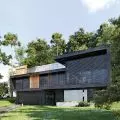About the artist's work
On March 26, 2024, Richard Serra, one of the most outstanding artists of the 20th century, passed away at the age of eighty-five. The American artist, a representative of the postminimalist trend in art, became primarily famous for his monumental sculptural installations made of oxidized steel, which today adorn prestigious museums, squares or parks scattered around the world.
Richard SERRA - American sculptor. He was born in San Francisco in 1939. He studied at the University of California at Berkeley, Santa Barbara and Yale University, and through scholarships spent time in Paris and Florence. Working in steel mills influenced his choice of materials - he created with steel with lead. His work combined a commitment to the space he intervened in with the sincerity of the material he used. The artist died in 2024.
Porten and Slugten (1983-1986) on the grounds of the Louisiana Museum of Contemporary Art near Copenhagen
Photo: Bartosz Haduch, Michal Haduch
Serra was born on November 2, 1938 in San Francisco. His mother, Gladys, was the daughter of Jewish immigrants from Odesa, while his father, Tony(incidentally, distantly related to Antoni Gaudí) came from Mallorca, Spain. Little Richard showed artistic interests from an early age - he reportedly never parted with his sketchbook. His dad worked as a pipe fitter at a local shipyard, and it was there that the boy had his first exposure to raw industrial materials. He was to be uniquely impressed by the tanker launching ceremony, which he attended when he was just four years old.
His fascination with heavy industry did not fade as he grew older, and as a teenager and student he was already making money in a steel mill, among other things. Interestingly, however, he initially studied English literature at the University of California at Berkeley and Santa Barbara. In the latter place he met muralists Rico Lebrun and Howard Warshaw, under whose influence he became more strongly interested in the visual arts.
Serra already continued his education at the opposite end of the United States, studying painting at the prestigious Yale University. There he met more famous artists: Robert Rauschenberg, Frank Stella or Josef Albers (whose assistant he was) and his first wife Nancy Graves, also an artist (the second was art critic Clara Weyergraf). At that time, thanks to scholarship programs, Serra also made several significant trips to Europe (France, Italy, Spain) and Asia (Japan), which greatly influenced his work. In Paris, the American became enthralled with the sculptures of Constantin Brâncuși, in Madrid with the paintings of Diego Velázquez (especially the famous painting "Las Meninas"), and in Kyoto with the architecture of the Zen Buddhist temple Myōshin-ji.
After returning from his voyages, Serra decided to permanently associate himself with the American East Coast. There, his circle of friends included other renowned artists such as Philip Glass, Walter de Maria and Robert Smithson. The latter he even supported in the creation of "Spiral Jetty", one of the most famous works of the land art movement. In recent years, Serra divided his time between three main points: a loft in New York's Manhattan, a vacation home on Canada's Cape Breton Island in Nova Scotia and a studio in the Orient settlement on Long Island. In the latter location, the artist died as a result of pneumonia.
Berlin Junction (1987) in Berlin
Photo: Bartosz Haduch, Michal Haduch
Richard Serra has left behind a rich artistic output of more than six decades. The American is undoubtedly best known for his large-scale installations of oxidized steel. Few people know, however, that his oeuvre includes more than just sculptural works. At the dawn of his career, he published "Verb List" (1967), a kind of artistic manifesto and at the same time a play on words. After a period of initial fascination with painting, he created numerous graphic works: drawings, sketches, lithographs, serigraphs, etchings or aquatints.
Interestingly, to his credit he also has several video art clips. However, he was most attracted to material projects in three dimensions, often created from unusual materials. The first harbingers of this were already assemblages using live and stuffed animals or a series of "Installation Drawings" (a kind of transition from 2D to 3D). Serra also experimented with materials such as fiberglass, rubber, latex, neon and especially molten lead. Only later did he become convinced of oxidized steel, to which (with a few exceptions, such as the "basalt" project "Áfangar " in Iceland and the concrete installation "El Muro" in Barcelona) he remained faithful until his death.
His metal monuments were created on different scales and in a variety of locations, often site-specific. This was the case, for example, with the famous installation "The Matter of Time" (1994-2005), consisting of eight large ellipses and spirals, filling one of the main spaces of the Guggenheim Museum in Bilbao.
The American's works, due to their sometimes thousands of tons of weight, are much more often found outdoors than in gallery interiors. In a heavily urbanized context are located, for example: "Berlin Junction" (1987) in Berlin (right next to the Philharmonic headquarters by Hans Scharoun) or "Intersection" (1992) in Basel (near the Stadtcasino building, recently restored by the Herzog & de Meuron studio). In a park environment, on the other hand, "Porten i Slugten" (1983-1986) was placed - on the grounds of the Louisiana Museum of Contemporary Art near Copenhagen, or "7" (2011) - on the seaside promenade in Doha, the capital of Qatar.
The latter country was also home to perhaps Serra's most spectacular realization, his peculiar magnum opus. For the installation "East-West/West-East" (2014) grows out of the sands of the Zekreet desert, and is made up of four monoliths several meters high spread over an area of almost a kilometer. This work can perhaps only be matched in its grandeur by another of Serra's works - "Te Tuhirangi Contour" (1999-2001). It is an impressive metal ribbon 6 meters high and as long as 257 meters, which is an extension of the picturesque mountainous landscape. However, it can be admired only by the most persistent art lovers - for it lies in remote New Zealand, within the Gibbs Farm sculpture park near Auckland.
Intersection (1992) in Basel
photo: Bartosz Haduch, Michal Haduch
It is also worth mentioning that in addition to his sculptural work, Serra also had the opportunity to collaborate on strictly architectural projects, such as the unrealized concept of the Lewis Residence near Cleveland (designed by Frank Gehry, Philip Johnson), the Monument to the Murdered Jews of Europe in Berlin (designed by Peter Eisenman) or the Glenstone Museum near Washington (designed by Thomas Phifer, in Poland more widely known thanks to the realization of the Museum of Modern Art in Warsaw).
Richard Serra has sometimes been described by art critics as the most outstanding contemporary sculptor. His career - from humble beginnings in an immigrant working-class family to international honors and laurels - can even be considered the fulfillment of the classic American dream. Serra has lived to see solo exhibitions in the world's most important galleries, including Paris' Centre Pompidou, Madrid's Queen Sofia Museum and New York's MoMA (two retrospectives), among others.
Today, his works can be found in the most distinguished collections, both public and private. Serra himself has been honored with many distinctions, including the French Legion of Honor (2015), Spain's Princess of Asturias Award (2010), the Golden Lion for lifetime achievement at the Venice Biennale (2001) or, finally, the industry's equivalent of the Nobel Prize - Japan's Praemium Imperiale award in sculpture (1994). The American's fame has even gone beyond the art world: in fact, in addition to documentaries, he appeared in a feature film - the third part of the eccentric series "Cremaster", directed by Matthew Barney.
7 (2011) - promenade in Doha, Qatar
Photo: Bartosz Haduch, Michal Haduch
Serra's career, however, has not been an uninterrupted streak of success. On more than one occasion, his work has faced criticism as well as misunderstanding. Such was the case with his project "Tilted Arc" (1981), which was removed from New York's Foley Square as a result of public protests and an eight-year court battle.
Regardless of various opinions, however, Richard Serra remains one of the most significant artists of our time, and this despite the fact that his massive, tactile, monochromatic sculptures contrast so sharply with the ephemeral tastes of the digital age. His works attempt to simultaneously capture movement, space and time, inviting viewers not only to admire, but to interact in a variety of ways. Richard Serra himself, moreover, used to say that he "works on the edge of what is feasible." He has succeeded like few others in brilliantly bending the boundaries of sculpture as an art form, literally and figuratively....
Bartosz HADUCH, Michal HADUCH
Photo credit: Authors











![Richard Serra [1938-2024].](https://cdn.architekturaibiznes.pl/upload/galerie/208198/images/kadr12/fit/730x480/richard-serra-431719.jpg)





![Richard Serra [1938-2024].](https://cdn.architekturaibiznes.pl/upload/galerie/208198/images/kadr17/fit/177x146/richard-serra-431719.jpg)












